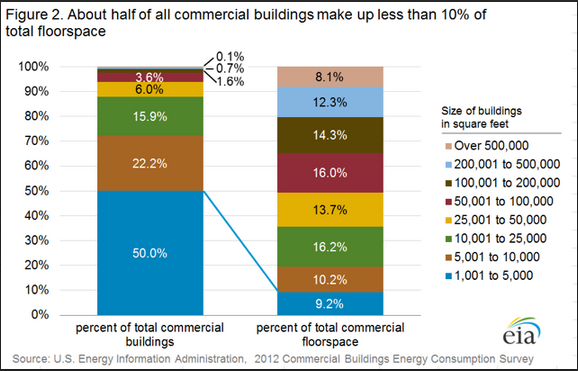|
May 2015
Column
AutomatedBuildings.com
|
[an error occurred while processing this directive]
(Click
Message to Learn More)
|
|
Building Automation for Small Commercial Buildings
The benefits to having
automation in smaller buildings include the ability to better control
energy usage, but also include monitoring, preventative maintenance and
enhanced grid integration.
|
Paul Ehrlich,
Ira
Goldschmidt
& Angela Lewis
Building
Intelligence Group
As
published

May Issue -
BAS Column
|
Generally
when we think about building automation (BAS) or system integration
projects, they are for larger projects such as schools, office
buildings and hospitals that are 50,000 square feet or larger.
These larger projects have more complicated systems, higher energy
usage, and can readily justify the investment in sophisticated
controls.
According to the U.S. Energy Information Administration though, these
larger buildings comprise only 6% of the U.S. commercial building
stock. Even looking in terms of floor-space, buildings less than
50,000 square feet comprise 50% of the total floor-space, which means
that they, in turn, use about half of the total energy consumed by all
commercial buildings.

This raises a question about how we can provide connection and
automation for these buildings, beyond what is available using
programmable thermostats. I see three distinct sets of solutions
evolving for these smaller commercial buildings. Each has great
potential and I expect that all three are going to continue to evolve:
Downsized BAS:
The same controls that are used for larger commercial buildings can
readily be used for smaller projects as well. In fact, this is a
fairly common approach for owners such as school districts that want to
use the same system to monitor larger and smaller schools. The
only real challenge here is cost, but suppliers are starting to offer
new options that make these large building systems attractive even on
smaller projects.
Small Commercial BAS:
There are a number of new products on the market that are specifically
focused on small commercial building automation. Most of these
start with a smart communicating thermostat (wired or wireless) that in
turn connects to a central panel which can control additional loads,
such as lighting. These systems are often focused on certain
types of buildings such as retail or restaurants. These systems
offer great potential at an attractive price point.
Upsized Home Automation:
[an error occurred while processing this directive][an error occurred while processing this directive]In
reality, many small commercial buildings are not much larger (or more
complicated) than a large residence. Home automation systems are
finally starting to take off. Systems that provide for web enabled
automation of HVAC, lighting, and plug loads are now available at your
local home center. Even more intriguing are some of the new
solutions being sold by cable and phone companies that offer security,
HVAC, lighting, fire and water detection. The entrance of large
technology companies into this space is anticipated to lead to rapid
growth. It is a reasonable expectation that the same systems
being designed for homeowners could easily be adapted for use in small
commercial buildings.
The benefits to having automation in smaller buildings include the
ability to better control energy usage, but also include monitoring,
preventative maintenance and enhanced grid integration. Look for these
new systems as you embark on your next small commercial building
project.
About the Authors
 Paul and Ira first
worked together on a series of ASHRAE projects
including the BACnet committee and Guideline 13 – Specifying DDC
Controls. The formation of Building Intelligence Group provided them
the ability to work together professionally providing assistance to
owners with the planning, design and development of Intelligent
Building Systems. Building Intelligence Group provides services for
clients worldwide including leading Universities, Corporations, and
Developers. More information can be found at
www.buildingintelligencegroup.com
We also invite you to contact
us directly at Paul@buildingintelligencegroup.com or
ira@buildingintelligencegroup.com
Paul and Ira first
worked together on a series of ASHRAE projects
including the BACnet committee and Guideline 13 – Specifying DDC
Controls. The formation of Building Intelligence Group provided them
the ability to work together professionally providing assistance to
owners with the planning, design and development of Intelligent
Building Systems. Building Intelligence Group provides services for
clients worldwide including leading Universities, Corporations, and
Developers. More information can be found at
www.buildingintelligencegroup.com
We also invite you to contact
us directly at Paul@buildingintelligencegroup.com or
ira@buildingintelligencegroup.com
footer
[an error occurred while processing this directive]
[Click Banner To Learn More]
[Home Page] [The
Automator] [About] [Subscribe
] [Contact
Us]
 Paul and Ira first
worked together on a series of ASHRAE projects
including the BACnet committee and Guideline 13 – Specifying DDC
Controls. The formation of Building Intelligence Group provided them
the ability to work together professionally providing assistance to
owners with the planning, design and development of Intelligent
Building Systems. Building Intelligence Group provides services for
clients worldwide including leading Universities, Corporations, and
Developers. More information can be found at
Paul and Ira first
worked together on a series of ASHRAE projects
including the BACnet committee and Guideline 13 – Specifying DDC
Controls. The formation of Building Intelligence Group provided them
the ability to work together professionally providing assistance to
owners with the planning, design and development of Intelligent
Building Systems. Building Intelligence Group provides services for
clients worldwide including leading Universities, Corporations, and
Developers. More information can be found at